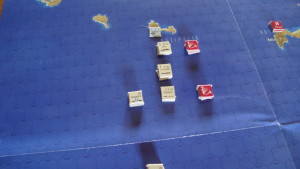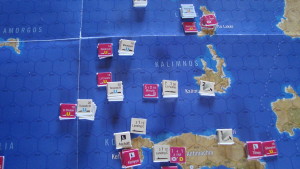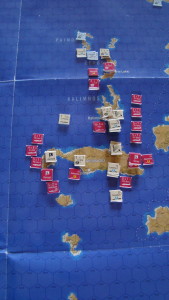I’m going to use the criteria cited in a previous post and published by “Lloyd”. Please read his article for insights concerning the criteria.
Decisions: Not much flexibility for the commanders. The VP schedule makes it very clear what has to be done, and the game mechanics concerning Rhodes takes the decision to invade out of the hands of the commander. However, the coordination of air and naval units is very demanding and interesting.
History: Both commanders are faced with the same operational problems as their historical counterparts. Both commanders have to “do a lot” with very little.
Luck: Plenty of that here with the variable number of impulses per turn, random day or night impulses, spotting, Luftwaffe availability, and Rhodes invasion die roll. The German commander needs lots of it in order to shepard his combat units across the Aegean. The Royal Navy needs the right die rolls in order to locate the invasion flotillas.
Atmosphere: It’s a tense game.
Mastery: Fairly easy to learn, and it took several replays to get the feel of coordinating air and naval forces. On the other hand, you can do everything “right” and still lose because of the Luck factor.
Tweaks: It’s a fairly comprehensive set of rules. I tweaked it to reduce the number of impulses per turn, messed around with the sighting die roll, and Luftwaffe availability. The solitaire task force rules – which I didn’t use – are very tweakable.
Abstraction: Really not much. Everything that was going on was going on, on the map (wow, what a sentence!).
Clarity: Good. However, I never figured out if early task force/naval units could all return.
Comprehensive: Very good. Lots of charts reduce the need to consult the rules.
Speed: Fairly slow. Even with low counter density, the joint operations involved made each impulse take some time.
Scenarios: Not much flexibility at all. The campaign game, with or without Rhodes. That’s it.
Summary: I enjoyed playing this game. It took a lot of time due to the variable impulses, which I eventually capped at three per turn, spotting rolls, and need to think through each move. The game definately grew on me, and I was intrigued by the operational problems faced by both commanders. It’s very playable solitaire, but I think it would move more quickly with two players because the game dynamics are so fatiguing without a break.


